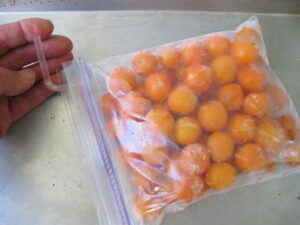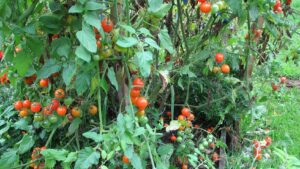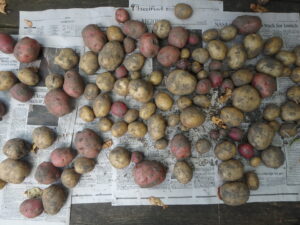Saving the Harvest
Posted on Tuesday, August 30, 2022 · Leave a Comment
Now is the time when gardeners often have too much fresh produce. People joke about locking their cars to keep neighbors from placing unneeded zucchinis in them. Our mothers and grandmothers labored over hot stoves on hot days to put up tomatoes in jars for winter, or making jam. Now there are better, easier ways to preserve the harvest. Let’s have a look.

A straw used to remove air from a bag of cherry tomatoes
I keep tomato products for later use in a number of ways. First and easiest, I freeze tomatoes whole. I put clean tomatoes in zipper bags and freeze them whole. Later, when I want tomatoes for a soup or stew, I just run hot water from the tap into a big bowl and drop in a few tomatoes. That softens them up so I can easily chop them, but it also loosens the skins. I just rub the skins with my fingers, and skin comes off. A few minutes later I chop them and they are just like canned tomatoes.
Want tomatoes for winter sandwiches? Cut them in thick slices and roast them on a sheet pan at 350 degrees until most of the moisture has gone. Then cool and place in zipper bags for storage in the freezer. When you need a tasty tomato in your sandwich, take a few slices out, and cook slightly in a toaster oven to thaw it.

Sun Gold tomatoes are very prolific and dry well for storage.
I grow many hundreds of cherry tomatoes each summer. I plant a dozen or more ‘Sun Gold’ cherry tomato plants each year, and each produces a bounty of rich, golden nuggets of flavor. What do I do with all those? I cut them in half and dry them in a food dehydrator, cut side up. When dry they will keep well in the pantry (or the freezer) in a wide-mouth quart jar. I toss a handful into every soup or stew I make.
Of course you can slice and dehydrate any kind of tomato. I have a friend who slices tomatoes, dries them until they are very crisp, and then grinds them in a food processor to make dried tomato flakes. She sprinkles the flakes into or on to a wide range of dishes. And she usually gives me a pint of them each year, which I treasure – I use it to add that mystical “umami” flavor to a dish.
A few words about food dehydrators. I have lots of experience with two good ones: NESCO American Harvest is a round dehydrator that will allow you to add many extra trays (up to 30, but with much increased drying time). NESCO dehydrators come with either top or bottom heat, so drying time is a bit uneven. The other is Excalibur, a square one with 9 trays. These blow air across the trays, and everything gets dry at once. They both have thermostats and timers that will turn them off when desired.
I use my dehydrators for drying apples and pears that are great for snacking. I cut slices about 3/8 inch thick and bag them up for snacking while they are still chewy. It looks like I will have a great grape harvest this year, and I may try making raisins. Set temperature at 125 to 135 degrees so you don’t break down vitamins.
I also use a dehydrator for drying hot peppers until they are brittle, then I grind them up in my coffee grinder to make hot pepper powder. That way I can sprinkle a little or a lot into a recipe, depending on who will be sharing dinner with me – I like food spicy.
I make tomato paste each summer, but that is more like the hard work my Grandmother did. I core the tomatoes and squeeze out excess juice and seeds, then cut them in half and drop into the Cuisinart. I run it until the tomatoes are a slurry. Then I pour the slurry into a heavy enameled cook pot. I heat it slowly, allowing the mixture to just slowly simmer (to avoid burning it).
It takes a couple of hours to fill the big kettle, and all evening for it to boil off the excess liquid. When I can literally stand up a soup spoon in the mix, I know it I thick enough. I leave the pot on the counter all night to let it cool and evaporate some more, and then in the morning I spoon the paste into ice cube trays and freeze. I put the cubes in bags or jars. It is nice to never need to remember to buy tomato paste – and to have a good use for damage tomatoes that might otherwise end up in the compost. I cut out the bad spots, and use every one.
I have never gotten excited about making jams or jellies. But if you have a dedicated freezer for storage, you can cook your raspberries or blueberries with sugar and spices, then freeze them. The canning process is lengthy and messy, so I generally avoid it. If you just want a little jam, make 3 or 4 jars and store in the fridge. It will be as tasty – and it gives you an excuse to spread some on ice cream, using it up before it get moldy.
Of course, storing food is the easiest, cheapest way to eat the harvest long after it. Winter squashes like butternut and blue Hubbard store for months in a cool, dry location. They store well for months under the bed in a guest bedroom with the radiators turned off.

Cure potatoes for a few days before storing.
When digging potatoes or pulling onions, try to do it in a dry time (not hard this summer). Lower moisture levels are better for storage. Cure them for a few days in a breezy place out of the sun. Store potatoes, carrots, celeriac and rutabagas in a place between 35 and 50 degrees with high humidity. Garlic and onions like lower humidity with cool temperatures. Sweet potatoes should never go in the fridge – they need to be stored in a warm room like the kitchen.
I try to eat something I grew every day of the year, and mostly I do that. Dried herbs, garlic and frozen foods are always there for me to use, so I do.
Henry gardens and cooks in Cornish Flat, NH. Reach him at
henry.homeyer@comcast.net. He is a regular speaker at libraries and garden clubs, and the author of 4 gardening books.





